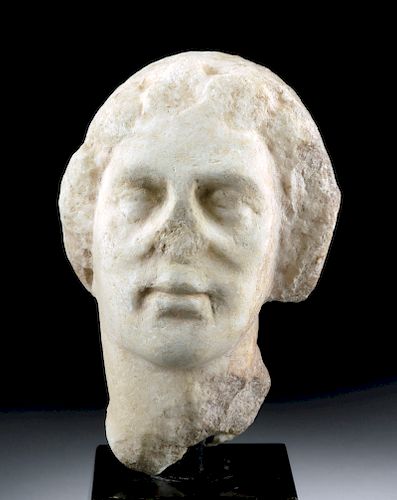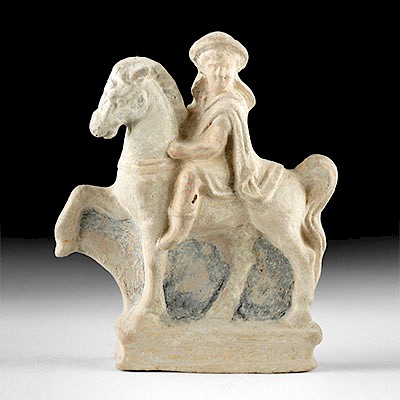Greek Hellenistic Marble Head of Woman
Lot 31
About Seller
Artemis Fine Arts
686 S Taylor Ave, Ste 106
Louisville, CO 80027
United States
Selling antiquities, ancient and ethnographic art online since 1993, Artemis Gallery specializes in Classical Antiquities (Egyptian, Greek, Roman, Near Eastern), Asian, Pre-Columbian, African / Tribal / Oceanographic art. Our extensive inventory includes pottery, stone, metal, wood, glass and textil...Read more
Estimate:
$4,000 - $6,000
Absentee vs Live bid
Two ways to bid:
- Leave a max absentee bid and the platform will bid on your behalf up to your maximum bid during the live auction.
- Bid live during the auction and your bids will be submitted real-time to the auctioneer.
Bid Increments
| Price | Bid Increment |
|---|---|
| $0 | $25 |
| $300 | $50 |
| $1,000 | $100 |
| $2,000 | $250 |
| $5,000 | $500 |
| $10,000 | $1,000 |
| $20,000 | $2,500 |
| $50,000 | $5,000 |
| $100,000 | $10,000 |
| $200,000 | $20,000 |
About Auction
By Artemis Fine Arts
May 9, 2019
Set Reminder
2019-05-09 10:00:00
2019-05-09 10:00:00
America/New_York
Bidsquare
Bidsquare : Ancient | Asian | Ethnographic
https://www.bidsquare.com/auctions/artemis-gallery/ancient-asian-ethnographic-4110
Featuring classical antiquities, ancient and ethnographic art from cultures encompassing the globe. All legally acquired, legal to sell. Satisfaction guaranteed. Convenient in-house shipping. Artemis Fine Arts info@artemisgallery.com
Featuring classical antiquities, ancient and ethnographic art from cultures encompassing the globe. All legally acquired, legal to sell. Satisfaction guaranteed. Convenient in-house shipping. Artemis Fine Arts info@artemisgallery.com
- Lot Description
Greece, Hellenistic Period, ca. late 4th to 1st century BCE. A fascinating marble head of an older woman, originally part of a larger statue. The sculpture is carved in the round, probably made to be displayed in a home or sanctuary, or possibly to grace a tomb. Her head is slightly tilted, in the naturalistic pose familiar from other Hellenistic statuary of women, like those made in terracotta at Tanagra. Her face features wideset eyes, slightly narrowed and with heavy lids. She has a large mouth with full lips and very distinctive cheekbones that give her face a slightly sunken appearance, creating the appearance of age. Her hair is curled at the front and in a bun at the back, carved to have an interesting texture. Size: 3" W x 4.5" H (7.6 cm x 11.4 cm); 6.35" H (16.1 cm) on included custom stand.
Inspired by historical knowledge like that collected at the Library of Alexandria, prominent Hellenistic art collectors commissioned large pieces based on public statues from the earlier Classical Period. More available art forms like this one echoed the naturalistic, detailed classical style that reached a pinnacle in small statuary during the Hellenistic period. Artisans looked to inspiration not only from the past but also from what they observed around them - usually women. Although women were also subjects of Classical sculpture, in the Hellenistic period, there was a flowering of artwork depicting them in naturalistic poses and everyday life - first as goddesses, later as ordinary women in a range of activities. This coincided with women becoming more powerful in public life - beginning with Olympias, Alexander the Great's mother who looked after the court of Macedon in his absence, Hellenistic women began to use their talents in the political sphere in a way that they were unable to during the Classical period (when Pericles famously said that the greatest glory of women was to be least talked about by men). Women gained economic and legal responsibilities and could become citizens in their own right, separate from their husbands. For example, a woman held the office of Phile of Priene, supervising the construction of a reservoir and aqueduct. Meanwhile, inscriptions from Delos reveal that women held property and slaves, as well as being responsible for their own debts. Looking at this sculpture, it is fascinating to think of her as a real person whose society recognized her as an individual with authority, rather than an idealized form.
Provenance: private East Coast, USA collection; ex-William Froelich collection, New York, USA, acquired in the 1970s
All items legal to buy/sell under U.S. Statute covering cultural patrimony Code 2600, CHAPTER 14, and are guaranteed to be as described or your money back.
A Certificate of Authenticity will accompany all winning bids.
We ship worldwide and handle all shipping in-house for your convenience.
#144149Head is lost from a larger sculpture. Nose is lost as is a small part of the front of the hair on one side. Weathering to back and one side of neck. Nice preserved details of eyes and mouth.Condition
- Shipping Info
-
All shipping is handled in-house for your convenience. Your invoice from Artemis Gallery will include shipping calculation instructions. If in doubt, please inquire BEFORE bidding for estimated shipping costs for individual items.
-
- Buyer's Premium



 EUR
EUR CAD
CAD AUD
AUD GBP
GBP MXN
MXN HKD
HKD CNY
CNY MYR
MYR SEK
SEK SGD
SGD CHF
CHF THB
THB














